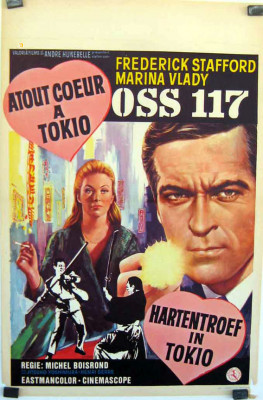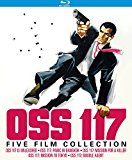| Reviews & Columns |
|
Reviews DVD TV on DVD Blu-ray 4K UHD International DVDs In Theaters Reviews by Studio Video Games Features Collector Series DVDs Easter Egg Database Interviews DVD Talk Radio Feature Articles Columns Anime Talk DVD Savant Horror DVDs The M.O.D. Squad Art House HD Talk Silent DVD
|
DVD Talk Forum |
|
|
| Resources |
|
DVD Price Search Customer Service #'s RCE Info Links |
|
Columns
|
|
|
OSS 117: Five Film Collection (OSS 117 Is Unleashed/Panic in Bangkok/Mission for a Killer/Mission to Tokyo/Double Agent)
Big screen adaptations were inevitable. In 1957 OSS 117 Is Not Dead (OSS 117 n'est pas mort) premiered, with Ivan Desny in the title role. No sequels followed but after the first James Bond movie, Dr. No (1962) initially earned $6 million against a modest $1 million production cost, OSS 117 was revived, running parallel to the Bond films for five movies through 1968. Apparently different production companies made a sixth, unrelated film, OSS 117 Takes a Vacation, released in 1970.
Kino Lober's five movie set consists of OSS 117 Is Unleashed (OSS 117 se déchaîne, 1963), OSS 117: Panic in Bangkok (Banco à Bangkok pour OSS 117, aka Shadow of Evil, 1964), OSS 117: Mission for a Killer (Furia à Bahia pour OSS 117, 1965), OSS 117: Mission to Tokyo (Atout coeur à Tokyo pour OSS 117, 1966), and OSS 117: Double Agent (Pas de roses pour OSS 117, 1968). Kerwin Mathews stars in the first two, Frederick Stafford in the third and fourth entry, and John Gavin in the last.
Licensed from Gaumont the movies, particularly the color and ‘scope titles, look gorgeous on Blu-ray, and for their location photography alone, mid-‘60s exoticness captured and preserved, they are worth seeing.
What interested parties should know up front is that these OSS 117 movies, while made parallel to the Bond movies, generally are not stylistically imitative, and that their pacing especially is much, much more leisurely. James Bond mania, building since the release of Dr. No (1962), peaked in early 1966 when Thunderball went into wide release. Bond imitation movies from all over the world soon followed glutting the market in earnest from late 1965, from as far away as Japan, Hong Kong, and India.
Few were any good. Movies like the Derek Flint and Matt Helm movies, produced in Hollywood, copied the superficial components but clearly didn't understand what made the initial 007 pictures so special. The only truly exceptional movies riding Bond's coattails were the three Harry Palmer movies starring Michael Caine (particularly the first one, The Ipcress File), movies supervised by 007 co-producer Harry Saltzman; and The Spy Who Came in From the Cold (1965). In very different ways all four shrewdly refute the glamour of the early Bonds and even condemn the hypocrisy of so-called British democracy.
In any case, the OSS 117 films fall into yet another different category. They imitate the early Bonds in small ways: fight scenes copy Bond editor Peter Hunt's innovative elimination of several frames of footage to accelerate kinetic bits of violence. (The OSS 117 movies, however, don't do this nearly as effectively as Hunt did.) There are a few high-tech gadgets, but nothing on the level of Bond's souped-up Aston Martin.
No, if anything the OSS 117 movies mostly resemble the lower-key methodology of the Ian Fleming novels, following its solitary spy-hero as he works through a mission, bit-by-bit, one clue leading to another, generally building toward a big action climax, with a lot of womanizing along the way. This most obviously manifests in vastly slower pacing. Where even the early Bonds were careful to include a big, fast action set piece every reel, the OSS 117 movies are so leisurely that, even by mid-1960s standards, they're more than a little draggy. A great deal of unnecessary action (or non-action) plays out to its restless audience, with most scenes a good 25% longer than they need be.
If one goes into the series expecting the slam-bang pacing of Bond or even Matt Helm they're certain to be disappointed. Indeed, I ended up watching several of the pictures broken up over several days, which helped, but they are worthwhile.
The first movie, the only one in black-and-white and 1.66:1 widescreen (the middle three are in color and 2.35:1 Franscope, and the last in 1.85:1 widescreen, despite a misprint on the packaging), is modestly but handsomely produced, with much underwater photography, and with most of the story back-dropped by the stunning cliffs of Bonifacio, in Corsica. The story involves a handful of characters, with many scenes playing out in cramped apartments or aboard small boats, yet it has the flavor of a taut espionage thriller.
In both this and the second OSS 117 adventure, Kerwin Mathews is effortlessly attractive and believable. Regrettably he and the other English-speaking leads seem to be dubbed into French - no English-dubbed versions are included - but that he even manages to charm while simultaneously sexist, to the point of assault by today's standards. Perhaps an awareness of Mathews's homosexuality, apparently fairly openly by this point in his career, softens the blow of those now politically incorrect moments.
The movies, except the last one to some degree, almost completely lack the grimly driven tone of Bond and the brutality of the best Fleming novels and the early films. Here, OSS 117 is basically unflappable, unfazed when in danger and c'est la vie when an associate or anyone is found murdered. In Panic in Bangkok the production values go way up, with lots of footage of Mathews and other members of the cast tooling around Thailand in "stolen" shots among the populace. Only once did I catch a passerby smiling and waving to the camera. Anyway, the appeal of watching Mathews driving and strolling around Bangkok (and, later, the other OSS 117 stars in other locales) is enormously appealing. So many of these locations have irrevocably lost a lot of their charm through modernization and globalization, just as the classic cars and ‘60s fashions have become distant memories. And, unlike the Bond movies, so popular that by 1966 shooting on location with superstar Sean Connery had become all but impossible, in these movies the actors walk and drive freely all over the place. No need to recreate scenes on a soundstage in front of a process screen.
For reasons not clear, series director André Hunebelle became enamored of Czech-born, multilingual Frederick Stafford while in Bangkok, and offered him the lead role for movies three and four. Outside of Europe, Stafford is remembered solely for his top-billed role in Alfred Hitchcock's Topaz (1969). I've seen Topaz four or five times through the years, and I still barely remember Stafford in it. He leaves much the same non-impression here. He's not a horrible actor, decent in the action scenes, and reasonably handsome, sort of a cross between Sean Connery and Yves Montand. But he's dull as dishwater.
His two films, set in Brazil and Japan, continue the same glossy polish and travelogue-like qualities of the second OSS 117 movie. The last one, now starring John Gavin (Psycho, Spartacus), abandons this look for the most part. It looks less like a ‘60s spy film than a proto-poliziotteschi, the specifically Italian-flavored crime and action film popular in the 1970s. It's also unusual in that it seems to have been written and produced to maximize its international appeal. Unlike the other films, where working-class Thais and Japanese all casually speak French, in this film alone scenes in Washington D.C. are in English, scenes in Rome are in Italian, etc. Though Gavin is mostly dubbed, his own voice is heard a couple of times, while German actor Curd Jürgens may have dubbed his French dialogue personally. That film also offers maybe the best cast, with Luciana Paluzzi, Robert Hossein, George Eastman and others in supporting roles.
It's also interesting to note how (coincidentally) the OSS 117 movies pre-date Bond here and there, filming in Thailand and Japan ahead of the Connery and Roger Moore films, as well as actors like Jürgens.
Video & Audio
Kino Lorber's Blu-rays, licensed from Gaumont, looks terrific. The first one, in black-and-white, has excellent contrast and inky blacks, while the later color ones look close to flawless if a little "hot" with the color, though that would seem more an avoidance of modern-day color correction tastes, and perhaps truer to how these movies looked when they were new, so no complaints there. All are in French with English subtitles, with no English-dubbed versions offered. The only Extra Feature are trailers for three of the films.
Parting Thoughts
Long unavailable in the U.S., OSS 117: Five Film Collection is a most welcome release. The transfers are great, and the films are fun, if you can get into the right frame of mind while watching them. Highly Recommended.
Stuart Galbraith IV is the Kyoto-based film historian largely absent from reviewing these days while he restores a 200-year-old Japanese farmhouse.
|
| Popular Reviews |
| Sponsored Links |
|
|
| Sponsored Links |
|
|
| Release List | Reviews | Shop | Newsletter | Forum | DVD Giveaways | Blu-Ray | Advertise |
|
Copyright 2024 DVDTalk.com All Rights Reserved. Legal Info, Privacy Policy, Terms of Use,
Manage Preferences,
Your Privacy Choices | |||||||
















